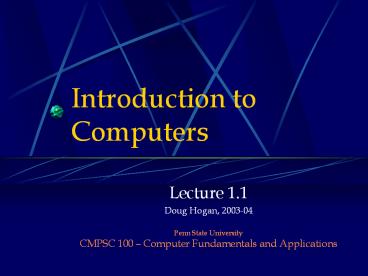Introduction to Computers PowerPoint PPT Presentation
1 / 21
Title: Introduction to Computers
1
Introduction to Computers
- Lecture 1.1
- Doug Hogan, 2003-04
- Penn State UniversityCMPSC 100 Computer
Fundamentals and Applications
2
Questions?
- Questions on syllabus?
3
Office Hours
- In 338E IST drop-in
- Tuesday, 1-2 p.m.
- Wednesday, 1230-130 p.m.
- and by appointment
- You may find me there other times too
- Virtual on Instant Messenger (cmpsc100)
- whenever not away
- as requested
- look at profile of the account
4
Attributes of Computers
- Speed
- Reliability
- Accuracy
- Storage
- Communication
5
Applications
- Word processing
- Financial management
- Shopping
- Entertainment
- Many more
6
Components of a Computer
- Central processing unit (CPU)
- Memory
- Input devices
- Output devices
- Storage devices
7
Central Processing Unit (CPU)
- Basic job handle processing of instructions
- Whats an instruction?
- Two parts
- Control Unit (CU)
- Arithmetic and Logic Unit (ALU)
8
The ALU
- Built up from digital logic gates
- AND
- OR
- NOT
- most primitive level
9
Memory
- Holds programs that are currently running and the
data being used by those programs. - Two categories
- Read-only memory (ROM)
- can only read data
- Random-access memory (RAM)
- can read and write information
10
Memory sizes
- base unit 1 bit binary digit, 0 or 1
- 8 bits 1 byte (B)
- 1000 bytes 1 kilobyte (KB)
- 1000 KB 1,000,000 B 1 megabyte (MB)
- 1000 MB 1,000,000,000 B 1 gigabyte (GB)
11
Memory
- Related data organized into files
12
Storage Devices
- Floppy disk
- 3.5 inches, 1.44 MB
- Hard disk
- typically sizes in GB
- Compact disc (CD)
- 650-700 MB
- CD-ROM read-only memory
- CD-R recordable
- CD-RW rewritable
13
More Storage Devices
- Digital Versitale/Video Disc (DVD)
- 4.7 GB
- Zip disks and tape drives
- varies
14
Input Devices
- mouse
- keyboard
- scanner
- camera
- microphone
15
Output Devices
- monitor
- cathode ray tube (CRT)
- liquid crystal display (LCD)
- printer
- speakers
16
Hardware vs. Software
- Hardware
- essentially, things you can touch
- input, output, storage devices
- Software
- essentially, what the computer knows
- data, 0s and 1s
- programs
17
Software Overview
- System software
- Controls basic operations of computer
- The operating system
- manages memory, files, application software
- File management tasks deleting, etc.
18
Software Overview
- Application software
- Not essential to system running
- Enables you to perform specific tasks
- Ex
- Office software
- Web browsers
- Media players
- Games
19
Keyboard
20
Keyboard Specifics
- CapsLock and Shift
- NumLock and numeric keypad
- Esc
- Editing and navigation keys
- insert, delete, home, end, page up, page down
- Function keys
- Ctrl, Alt
- PrintScreen
21
Mouse operations buttons
- Click left button
- Click and drag
- Shift-click, Ctrl-click
- Double click
- Triple click
- Right click
- Scroll wheel

